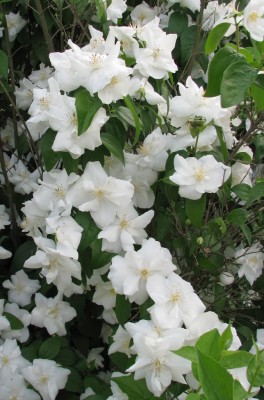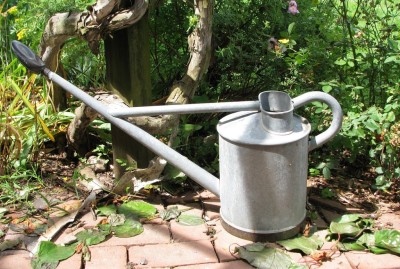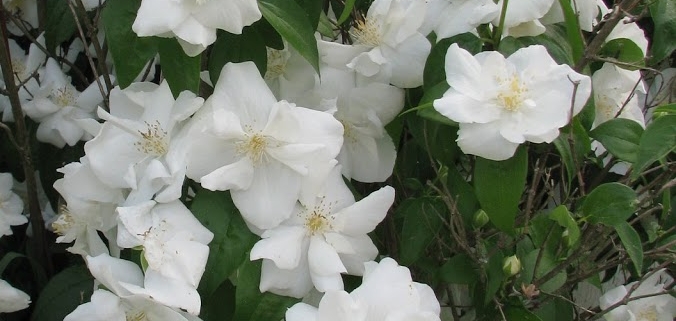[mockorange, watering can, poppies]
Up until last week, every time I looked at my mockorange, I wondered why I would have planted such a bush so prominently right next to the greenhouse door. The bush looked like nothing more than a blob of greenery, a not especially graceful blob of greenery.
This week I did an about-face on my mockorange; I’m enthralled with it as it sits there draped in large, lily-white, semi-double flowers. And if those flowers weren’t enough just to look at, they fill the air with a most delicious, fresh scent that is vaguely reminiscent of orange blossoms.

Mine is not just any old mockorange. It’s a named variety, perhaps Flora Plena. Blossoms on run-of-the-mill mock oranges open earlier and are smaller and have single rows of petals.
It’s sad, but I know I won’t be looking fondly upon my mockorange again in another week or so. Until next year.
———————————————
You’d think it was a simple enough question from my brother: “I want to get a good watering can. What would you recommend that’s reasonable?”
Let me begin by stating that I own, not one but two (one for each hand), of what I consider to be the Cadillac (Prius?) of watering cans: The Haw’s Classic Long Reach Galvanized watering can. Each has a nice balance, holds a reasonable amount of water, and has a rose – the thing that breaks the stream of water into many, gentler streams – from which water falls like a gentle rain, but not too slowly.

Yet I wouldn’t recommend this watering can to my brother. I paid
about $60 twenty or so years ago, but now they cost more than twice that! You can get a similar plastic watering can for about $20. I had one. It only lasted a couple of seasons. So what would I recommend? First and foremost: No plastic. Plastic watering cans don’t last.
No sooner had I started asking whether the can was for houseplants or outdoor plants than my brother rolled his eyes and suggested that perhaps he should have started with a simpler question, like what kind of pencil I’d recommend for keeping garden notes. Ha, ha. But if a watering can is for watering just houseplants, you don’t want it to have a rose. For general watering, indoors and out, a watering can should have a removable rose. (My Haw’s does.)
Okay, I’ll make it simple. For general, outdoor use, I suggest a can that holds about 2 gallons of water, is made of heavy metal (hot-dipped galvanized ones usually are), and, unless decoration is also to be one of its functions, is not in the cutesy shape of a snail, elephant, pig, or other animal.
A good hardware store might have what’s needed, as well as web retailers, for 20 or 30 dollars. Haws does makes “SlimCan Galvanized Watering Can” that sells for about $70. It that might work a tad better than the others.
—————————————
I may have gone overboard with poppies this year. But can any garden have too many poppies?
The overboarded poppies to which I refer may seem, at first glance, to be the usual Oriental poppies (Papaver orientalis). But no, these poppies are corn poppies (Papaver rhoeas). Both poppy species have petals that are as delicate as fairy shawls and usually vivid red, but the red of corn poppies is more pure. And rather than unfolding on the ends of sprawling, clunky stems like Oriental poppies, corn poppy flowers perch high on the ends of delicate, upright, 3-foot-high stalks. A most significant difference between the two species is that corn poppies are annuals, while Oriental poppies are perennials.
Like most poppies, corn poppies transplant poorly so are best sown where they are to grow. The seeds are almost as fine as dust so there’s a natural tendency to doubt that they could amount to anything, especially just sprinkled on bare ground. With such doubts in mind, in early April I sprinkled two packets of the fine seed over a bed soon that I knew would be dense with various fritillaria and allium species, as well as licorice mint (Agastache), snow-in-summer, soapwort (Saponaria), and espaliered Asian pears.
I should have had faith. After all, corn poppy is called corn poppy because it once dotted (i.e. was a weed in) Europe’s corn fields, “corn” meaning any “grain” in the Queen’s English. My corn poppies sprouted with vigor, as did some seeds from last year’s corn poppies, so that now parts of that bed are happy riots of scarlet blossoms.
I had also sprinkled on that bed seeds another annual poppy, California poppy, a low-growing plant with ferny leaves and buttery yellow flowers. There’s no sign of these poppies, which were evidently overrun by the corn poppies.





Just a short watering can comment- Rubbermaid had made a wonderful 2 gallon can with a removeable rose. I have two that have lasted for years and years maybe 10+. I believe that unfortunately they are no longer in production but I keep my eye out at yard sales. I will buy as many as I find.